Table of Contents
Introduction
According to Car Safety Statistics, Car safety encompasses essential features and practices aimed at protecting occupants and preventing accidents.
Passive safety measures include seat belts, airbags, crumple zones, and child safety seats. All are designed to mitigate injury in the event of a collision.
Active safety features like ABS, ESC, collision warning systems, and blind spot monitoring enhance driver control and awareness on the road.
Safe driving practices such as defensive driving, avoiding distractions, and regular vehicle maintenance. Adherence to speed limits, and abstaining from driving under the influence further contribute to overall road safety.
Together, these elements create a comprehensive approach to car safety. Integrating both vehicle technologies and responsible driving behaviors to reduce risks and enhance protection for everyone on the road.
Editor’s Choice
- Between 2009 and 2019, the rate of car traffic accidents across various countries demonstrated notable trends. In the United States, traffic accidents increased by 25.9%, rising from 1,548,000 in 2009.
- In 2023, the global car safety market revenue stood at USD 145.3 billion.
- By 2033, the market is projected to reach USD 363.4 billion. With active safety revenues at USD 266.7 billion and passive safety at USD 96.7 billion.
- From 2011 onwards, side airbags were ubiquitous in both domestic and imported cars in the United States, with both achieving a 100% penetration rate.
- A survey on the reluctance to use self-driving cars revealed several key concerns among respondents. The most significant reason, cited by 50% of respondents, was that they wouldn’t feel safe in a self-driving car.
- 92% of Indian customers want cars to undergo crash tests and receive safety ratings.
- In Australia, the government has committed $33.4 billion over four years to improve road safety through infrastructure investments. Grants for sector-led initiatives, and programs like the Car Safety Ratings Program. Which supports independent vehicle safety assessments and promotes consumer awareness.
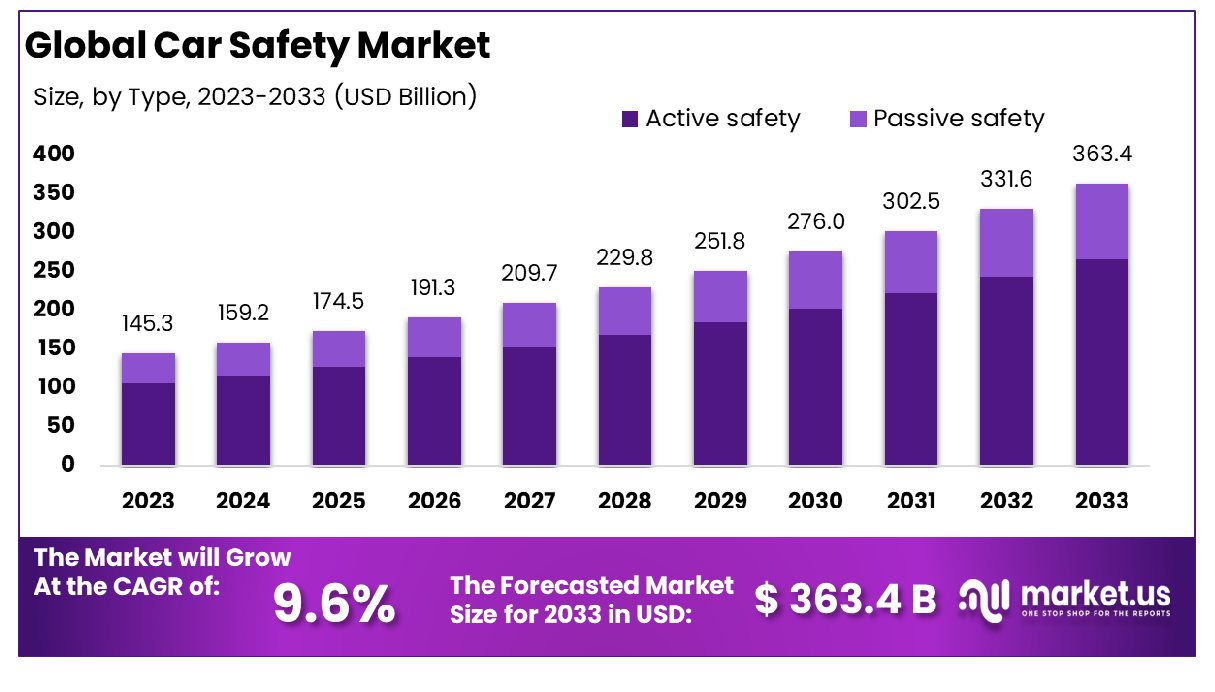
Car Safety Market Overview
Global Car Safety Market Size
- The global car safety market has shown significant growth over the past decade and is projected to continue its upward trajectory at a CAGR of 9.60%.
- In 2023, the market revenue stood at USD 145.3 billion.
- The growth is expected to persist, with revenues projected to hit USD 302.5 billion in 2031, USD 331.6 billion in 2032, and an impressive USD 363.4 billion by 2033.
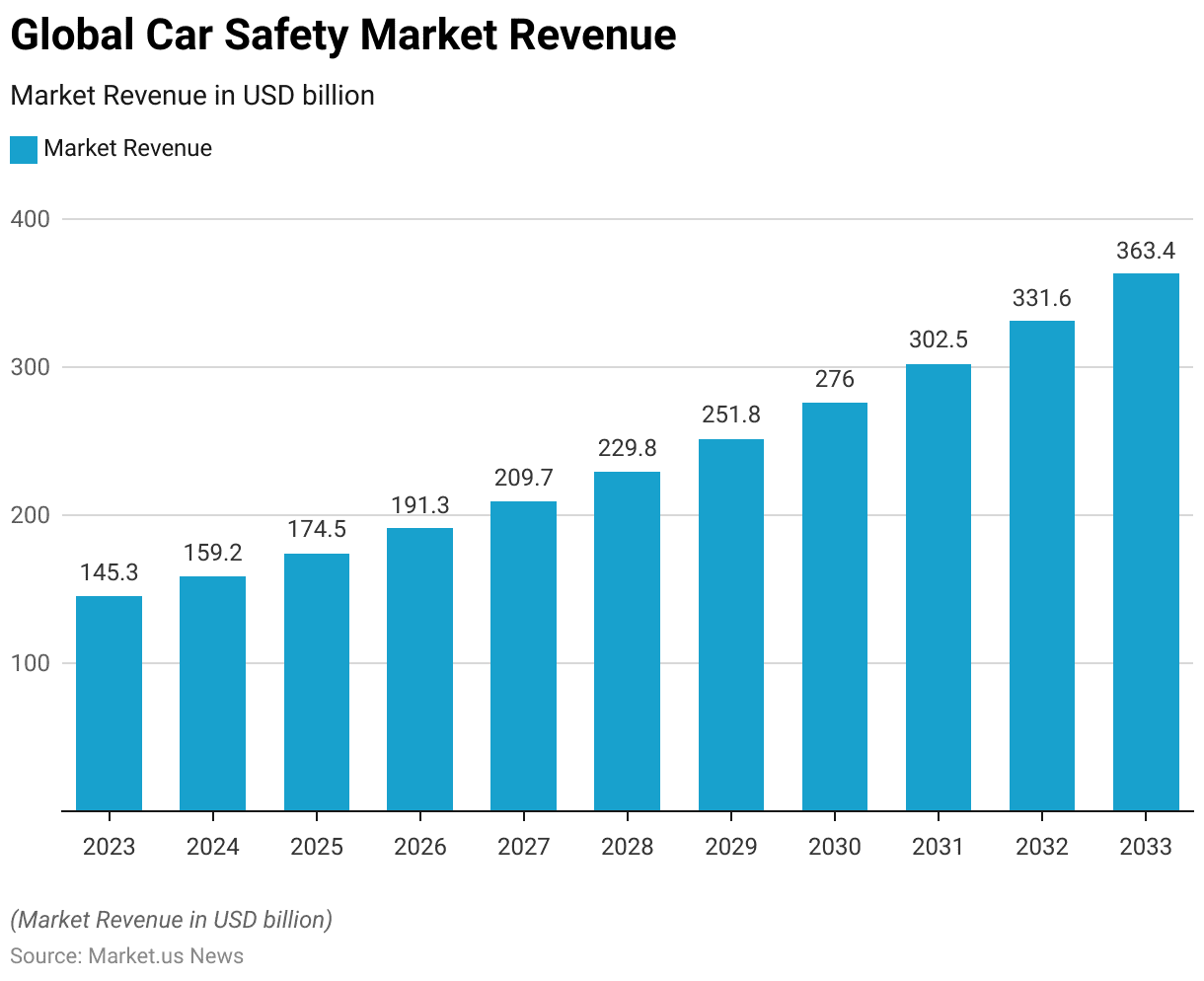
Global Car Safety Market Size – By Type
- The global car safety market is experiencing robust growth, segmented into active and passive safety components. In 2023, the total market revenue was USD 145.3 billion. With active safety contributing USD 106.7 billion and passive safety USD 38.6 billion.
- The trend is set to continue through 2032, with an estimated USD 331.6 billion (USD 243.4 billion active, USD 88.2 billion passive), and by 2033, the market is projected to reach USD 363.4 billion, with active safety revenues at USD 266.7 billion and passive safety at USD 96.7 billion.

Car Accidents – Role in Increasing Emphasis on Car Safety
Rise in Car Accidents and Deaths – By Country
- In 2019, the incidence of car accidents and resulting fatalities varied considerably across several countries. The United States reported the highest total number of accidents at 1,949,000, translating to 5,938 accidents per million people and 110 deaths per million.
- Germany had 300,143 total accidents, with 3,612 accidents per million people and a death rate of 37 per million. Turkey recorded 174,896 accidents, equating to 2,118 accidents per million and 66 deaths per million.
- Italy’s figures were 172,183 total accidents, 2,883 accidents per million people, and 53 deaths per million. The United Kingdom reported 123,212 accidents, 1,847 per million people, and 27 deaths per million.
- In Canada, there were 105,791 accidents, resulting in 2,814 accidents per million people and 47 deaths per million. Spain had 104,080 accidents, with 2,208 accidents per million people and 37 deaths per million.
- France reported 56,006 accidents, equating to 833 per million people and 48 deaths per million. Belgium recorded 37,699 accidents, with a high rate of 3,983 accidents per million people and 68 deaths per million.
- Lastly, Portugal had 37,213 accidents, resulting in 3,618 accidents per million people and 67 deaths per million.
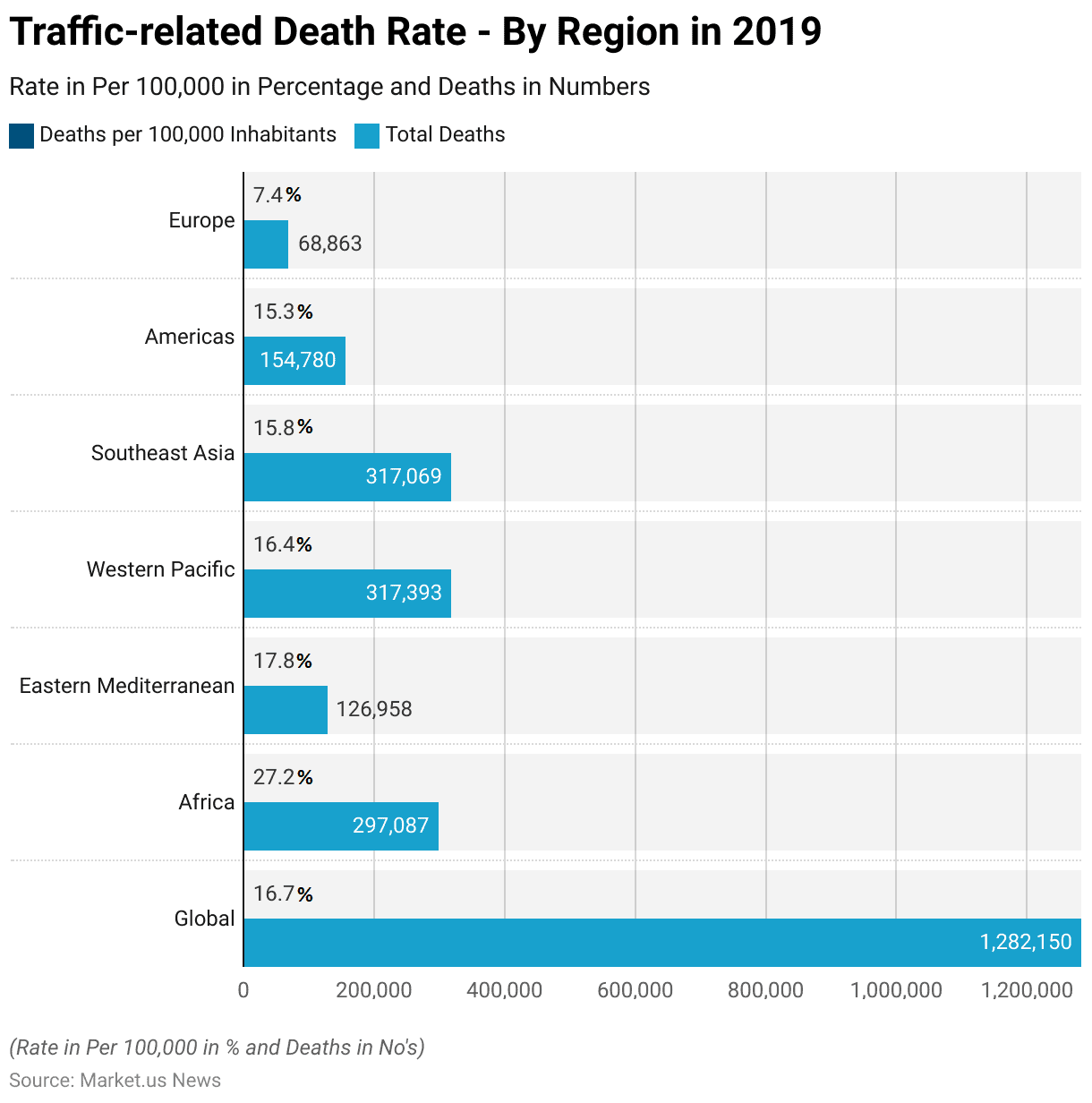
Use of Car Safety Features
Seat Belts
- In 2013, seat belt usage rates in selected countries worldwide showed considerable variation between rear and front seat occupants.
- Austria reported a 65% usage rate in the rear seat and 86% in the front seat. In the United States, the rates were 78% for the rear and 87% for the front. Finland exhibited higher usage, with 86% in the rear and 89% in the front.
- The Netherlands reported 82% for the rear and 96.6% for the front. Australia’s rates were notably high at 96% for the rear and 97% for the front. Japan had 68.2% rear seat belt use and 97.9% front seat use.
- Germany exhibited a high rate of 97% for the rear and 98% for the front. Sweden’s rates were 84% for the rear and 98% for the front. While France showed 87% for the rear and a leading 99% for the front.
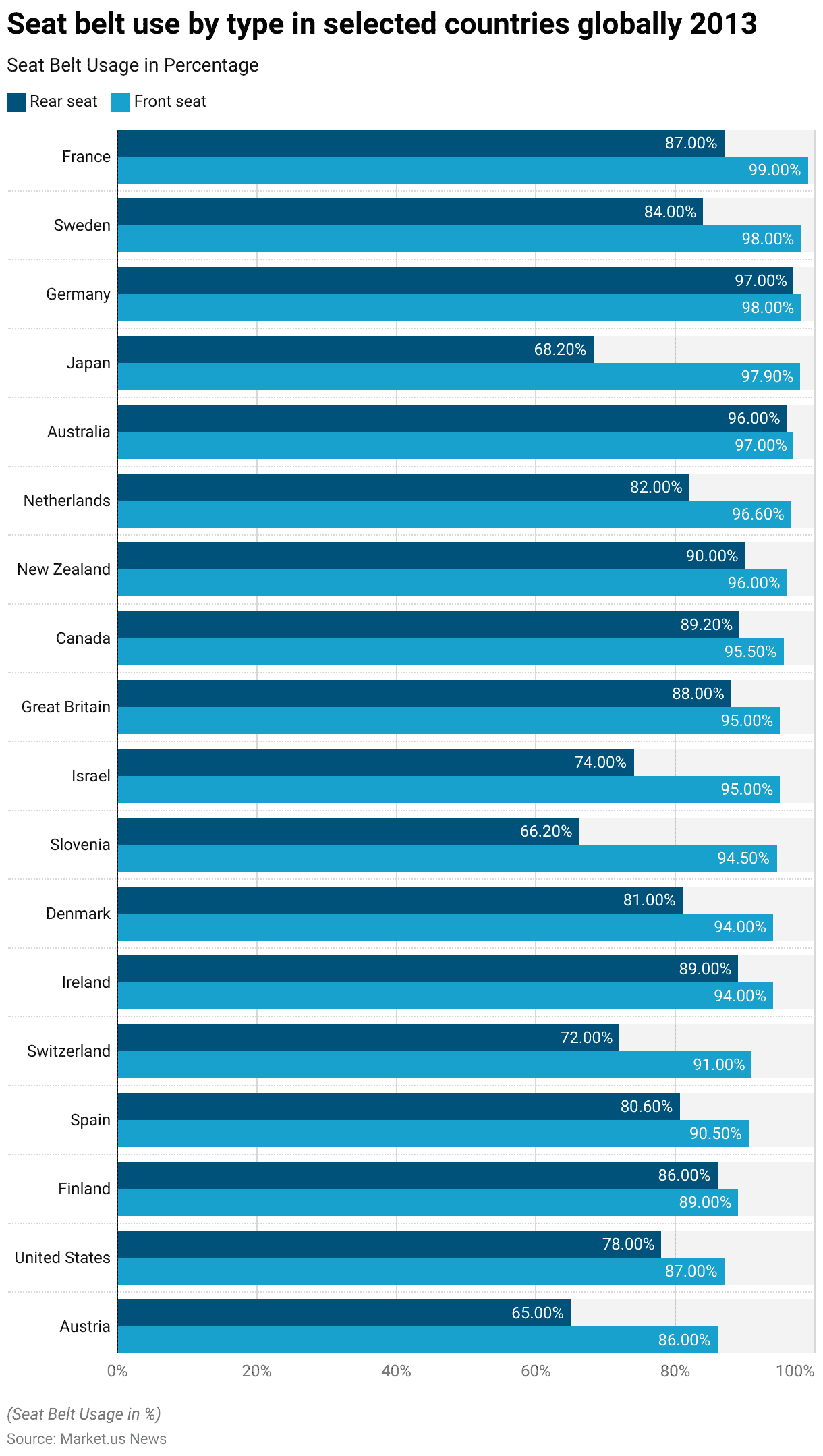
Airbags
- The penetration rate of side airbags in cars in the United States showed a remarkable increase from 2004 to 2015, with notable differences between domestic and imported vehicles.
- In 2004, side airbags were present in 28% of domestic cars and 78% of imported cars. By 2005, these figures rose to 34% for domestic and 81% for imported cars.
- From 2011 onwards, side airbags were ubiquitous in both domestic and imported cars, with both achieving a 100% penetration rate.
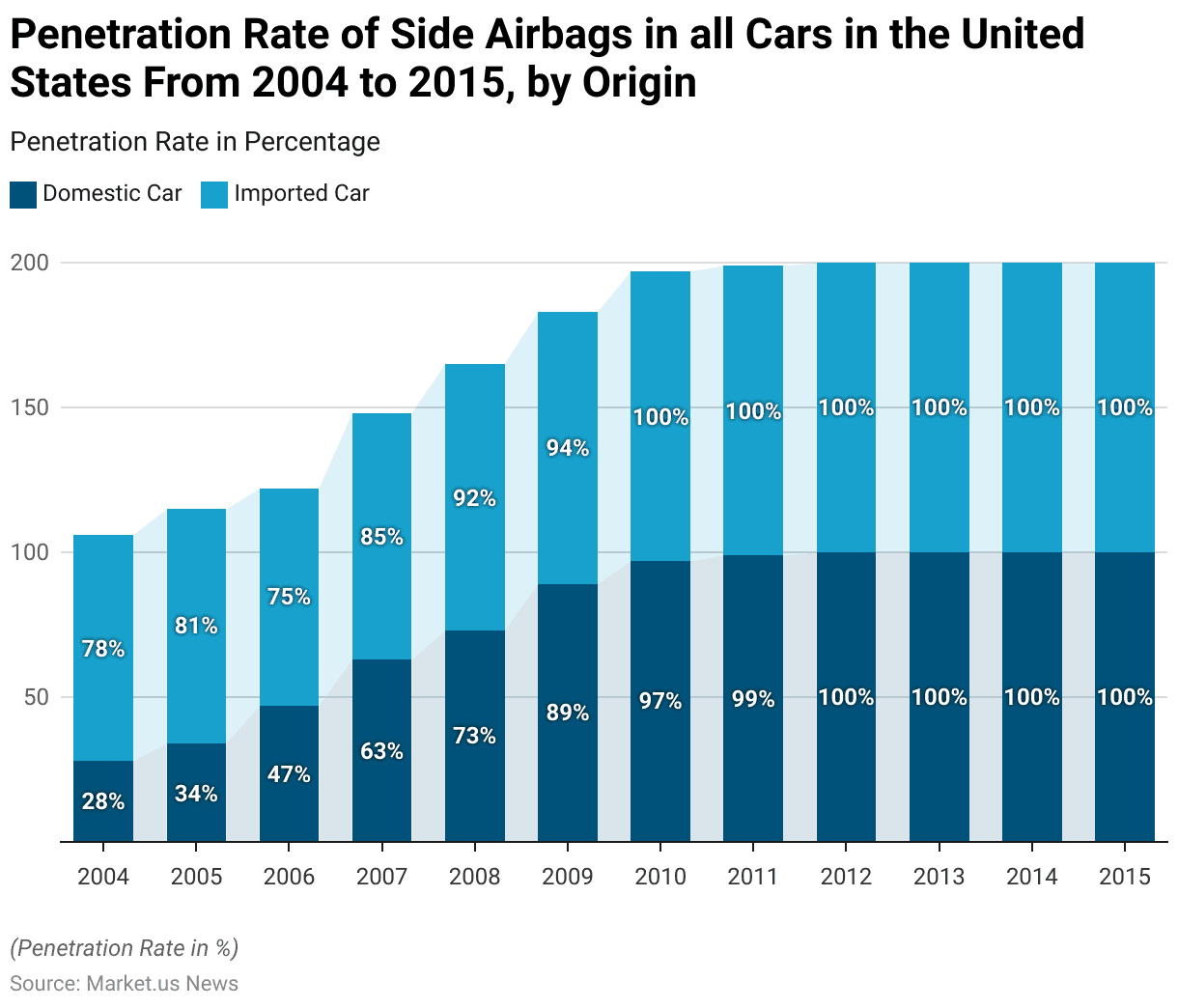
Booster Seat
- The use of booster seats among 4- to 7-year-old children in the United States has fluctuated significantly from 2006 to 2021.
- In 2006, 41% of children in this age group used booster seats.
- By 2011, booster seat usage had risen to 46.6%, maintaining a relatively high rate of 46.3% in 2013.
- However, the trend began to decline, with 44.5% in 2015 and further to 40.1% in 2017.
- The downward trend continued at 37% in 2019, and by 2021, the usage rate had fallen to 31%.
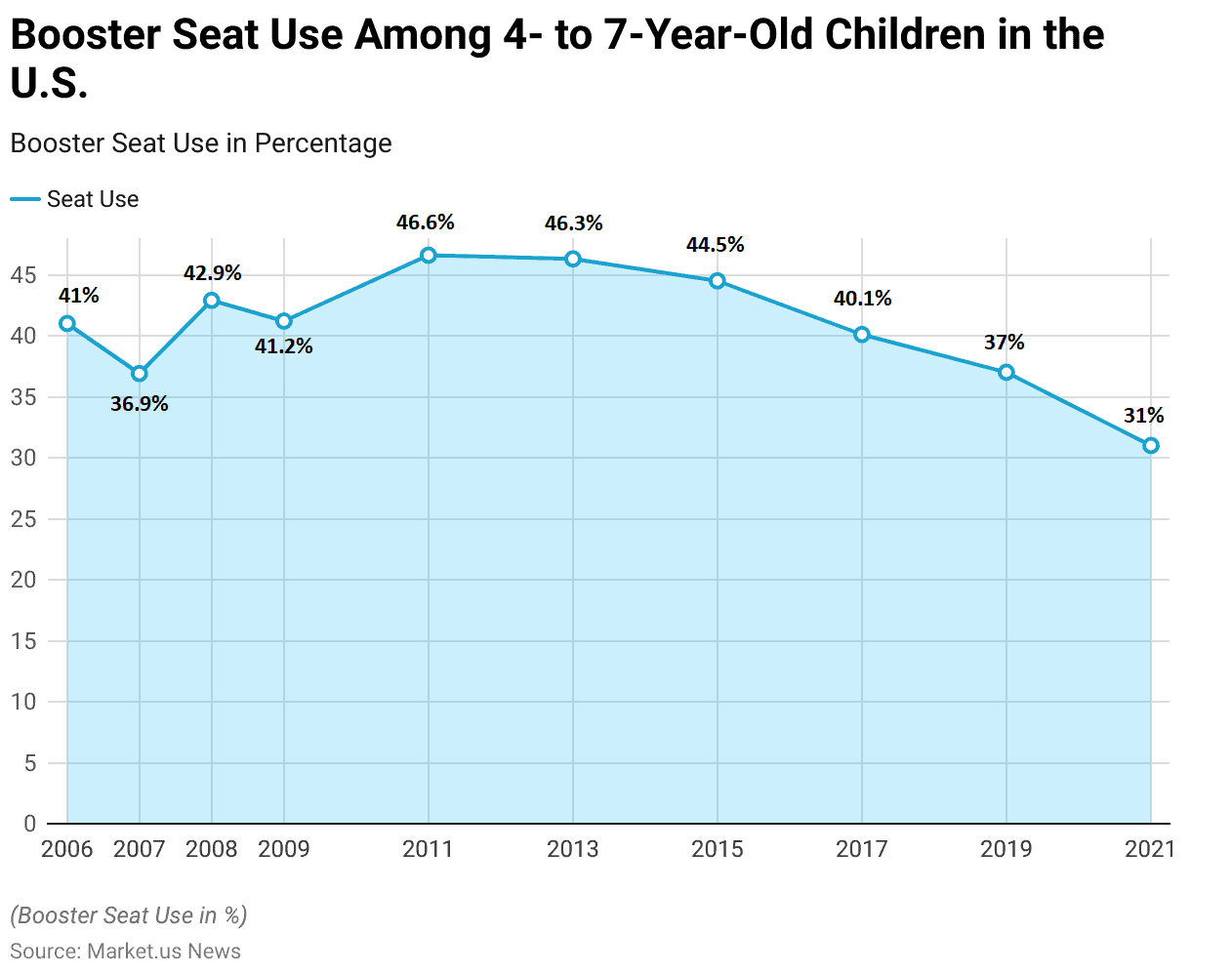
Autonomous Driving Cars Statistics
Adoption of Autonomous Driving in Newly Registered Cars
- The estimated share of newly registered cars worldwide by autonomous vehicles driving level from 2015 to 2025 demonstrates a significant shift towards higher levels of automation.
- In 2015, cars with Level 0 (no automation) constituted 45% of new registrations. While Level 1 (driver assistance) and Level 2 (partial automation) cars accounted for 45% and 10%, respectively.
- By 2020, the share of Level 0 cars had decreased to 19%, whereas Level 1 cars increased to 56%, and Level 2 cars saw a substantial rise to 25%.
- Projections for 2025 indicate a further decline in Level 0 cars to just 6%, while Level 1 cars are expected to represent 60% of new registrations. Level 2 cars are anticipated to hold a 23% share.
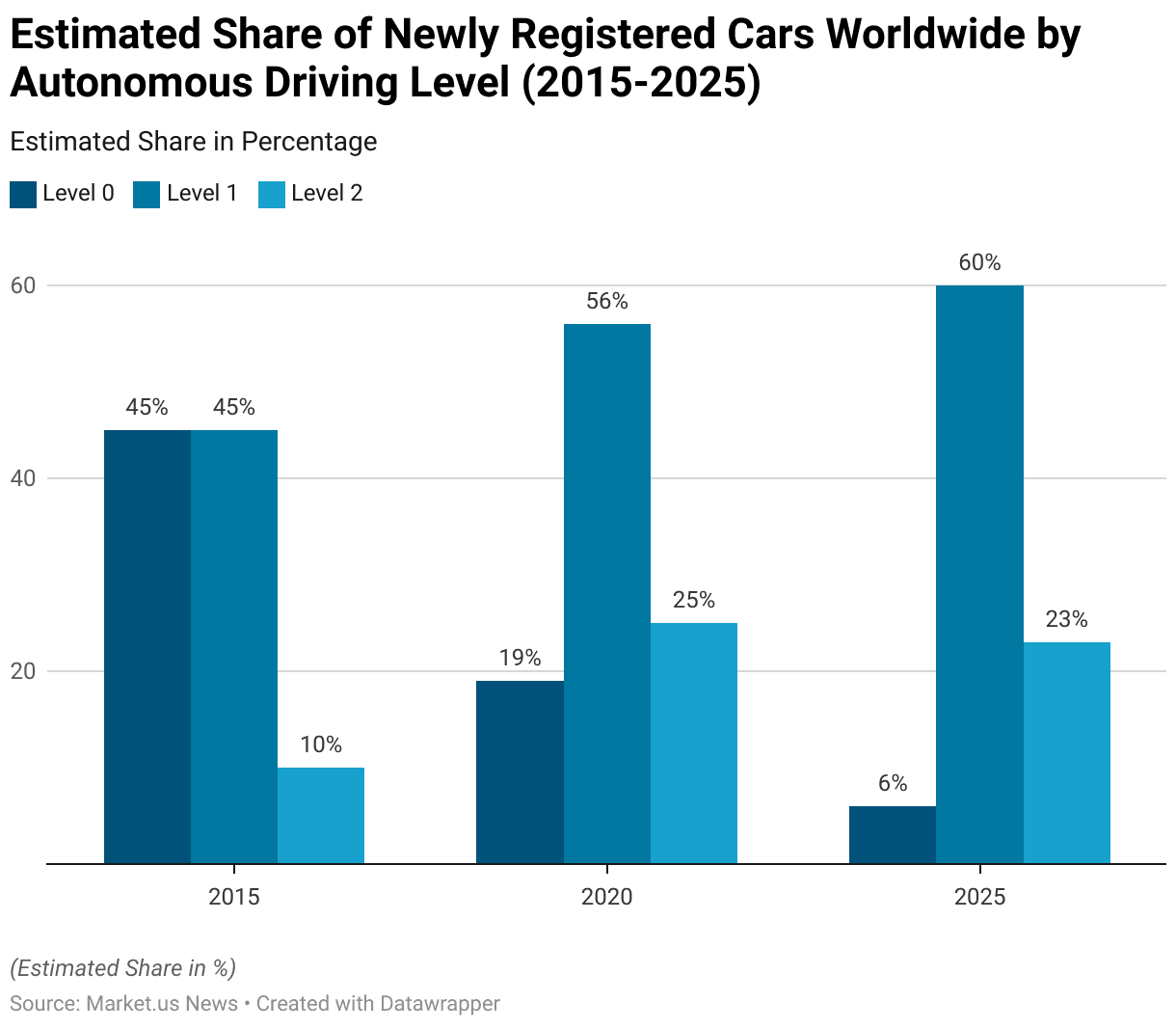
Concerns About Self-Driving Cars
- A survey on the reluctance to use self-driving cars revealed several key concerns among respondents.
- The most significant reason, cited by 50% of respondents, was that they wouldn’t feel safe in a self-driving car.
- Following this, 45% of respondents expressed a desire to maintain control at all times, and 43% were worried about the potential for the car to make mistakes.
- For 30% of respondents, driving was considered a pleasure they did not wish to forgo.
- Additionally, 27% felt they did not know enough about the technology, and 26% didn’t trust self-driving cars in mixed-traffic situations.
- Financial concerns also played a role, with 25% unwilling to pay for self-driving functionality.
- Lastly, 23% of respondents were concerned about the possibility of the car being hacked.
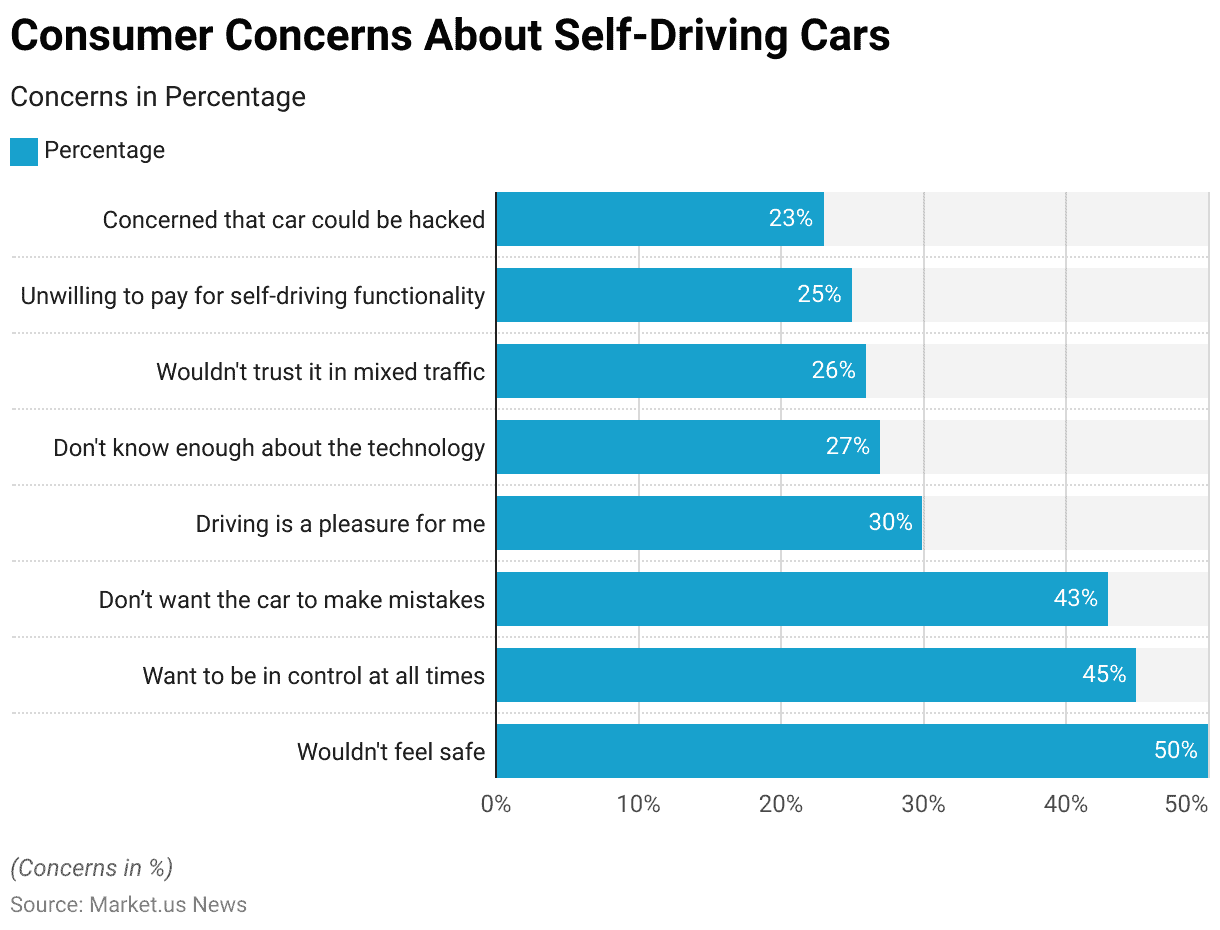
Consumer Preferences and Trends
- 92% of Indian customers want cars to undergo crash tests and receive safety ratings.
- For 47.6% of customers, safety is the top priority over other car features.
- Crash ratings are the foremost consideration in car purchasing decisions, with fuel efficiency coming in third.
- 92% believe that providing incentives for cars with safety features would be very effective.
- Only 30% of customers are knowledgeable about separate safety ratings for child/rear occupants.
- While 76% of customers are aware of the existence of two sets of 5-star safety ratings for crash tests, only 30% can identify the rating for child/rear occupant safety as one of them.
Initiatives to Promote Car Safety
- Various initiatives are being implemented worldwide to promote car safety.
- In the United States, the National Roadway Safety Strategy emphasizes a Safe System Approach, focusing on safer roads, safer vehicles, and safer speeds.
- It includes initiatives like updating safety manuals and promoting safety culture among state departments of transportation.
- In Australia, the government has committed $33.4 billion over four years to improve road safety through infrastructure investments, grants for sector-led initiatives, and programs like the Car Safety Ratings Program, which supports independent vehicle safety assessments and promotes consumer awareness.
- Globally, the Bloomberg Philanthropies Initiative for Global Road Safety funds projects aimed at strengthening road safety policies and implementing evidence-based interventions.
Car Safety Regulations
- Car safety regulations vary significantly by country, reflecting different standards and priorities.
- In the United States, the National Highway Traffic Safety Administration (NHTSA) mandates safety features such as seat belts, airbags, electronic stability control, and the LATCH child safety seat system. Recent proposals include the potential requirement for vehicle-to-vehicle communication technology.
- Moreover, In the European Union, regulations are more stringent, mandating advanced systems like automatic emergency braking, lane-keeping assistance, and intelligent speed assistance.
- Countries like Japan and Australia also enforce strict safety standards, including advanced driver assistance systems.
Discuss Your Needs With Our Analyst
Please share your requirements with more details so our analyst can check if they can solve your problem(s)





